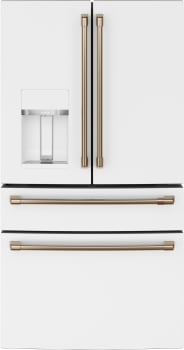GE Profile 23.1 cu. ft. French Door Refrigerator in Fingerprint Resistant Stainless Steel, ENERGY STAR and Counter Depth
Counter depth design creates a sleek built-in look. Advanced water filtration produces clean water. Resists fingerprints and smudges for a clean sleek appearance.
GE Profile products offer the best in contemporary design. Matched with the latest in appliance technologies to transform the way you live. Sporting a bold, dramatic look and state of the art features, this collection provides the perfect combination of style and innovation throughout your kitchen.
-
Counter-depth design – offers a built-in look by fitting nearly flush with surrounding cabinetry
- Fingerprint resistant stainless – easily wipe away smudges and fingerprints for a look that’s always sparkling clean
- Internal water dispenser – delivers filtered water with 1-touch
- Full-width, electronic temperature-controlled drawer with LED lights – 3 accurate settings deliver the optimal temperature for your favorite foods
- TwinChill evaporators – separate climates in the fresh food and freezer sections help keep foods fresh
- Advanced water filtration uses RPWFE replacement filter – reduces trace pharmaceuticals from water and ice (removes 98% of ibuprofen, atenolol, fluoxetine, progesterone and trimethoprim, these pharmaceuticals are not necessarily in all users’ water)
- Showcase LED lighting – positioned throughout the interior and under fresh food doors to spotlight foods inside the refrigerator and in the freezer
- Quick Space shelf – functions as a normal full-sized shelf when needed and easily slides down for instant storage flexibility
- 23.1 cu. ft. of total capacity
- Approximate dimensions (in.): 69-7/8 in. H x 35-3/4 in. W x 31-1/4 in. D
- Limited 1-year entire appliance warranty
Additional information
| Depth (Excluding Handles) | 28.75 |
|---|---|
| Depth (Including Handles) | 31.25 |
| Depth (Less Door) | 24.38 |
| Depth With Door Open 90 Degrees (In) | 43.38 |
| Height to Top of Door Hinge (in.) | 69.88 |
| Height to Top of Refrigerator (in.) | 69 |
| Product Depth x Height x Width (in.) | 31.25 x 69.88 x 35.75 |
| Refrigerator Width (In.) | 35.75 |
| Certifications and Listings | Energy Star,UL Listed |
| Manufacturer Warranty | Limited 1-year entire appliance |






by Mamaibar
Bought this refrigerator sight on seen due to the pandemic. Absolutely love it’s Sleek design. The counter depth is amazing gives us so much more room in our kitchen. What’s a little worried about the space inside but is very spacious and has a lot of room. The freezer is also very roomy with the ice maker inside. Didn’t realize it had water in the door which is also a bonus.
by Marc
We purchased the GE Profile French Door Refrigerator, because it had all the features that we wanted. The fingerprint resistant finish was a big plus. The shelving and door bins are easily adjusted to met any needs. The controls are very simple to use. The only thing that is annoying is the difficulty in removing the protective film in and around the door seals.
by Chrissy
We just got it, but I love the look of it and how it fits our space.
by Ragam
It’s a beautiful counter deep refrigerator, fits almost flush with the cabinets.It is quite finger print resistant, the motor is extremely quiet, I cannot tell whether it’s on or off. I have read some reviews about being noisy, the only noise that I hear is that of the ice falling into the bucket or the water solenoid filling the ice tray. Others complained of the refrigerator moving forward while trying to open the freezer door, if those people had lowered the front adjusting legs, they would have never been able to budge the refrigerator. I just remodeled my kitchen and this refrigerator looks so elegant.
by Sunny
I’ve had this for a few months. The pros are: 1) unbelievable amount of space BOTH inside and on the side doors. Plenty of room for tall items. 2) ice maker is inside freezer . If you buy one that’s on the outside, you will always have problems with leaking etc. Lots of room inside. 3) water dispenser inside 4) smudge resistant stainless steel. Easy to keep clean. 5) other then usual noises most refrigerators make, it’s not noisy. Cons: The freezer door is difficult to open. That is the only drawback. You have to pull hard to open it. If they could rectify it , it would be the “perfect” refrigerator abd I would have given it 5 stars.
by Keithcad
I researched a lot of refrigerators and this has the best volume, and affordability.
by Ona
I was needing a counter depth bc my kitchen is small. This did not disappoint ! This is a beautiful refrigerator and while a bit smaller bc it’s counter depth, it’s perfect for us!! Love GE!
by Pisqua
Just love my new fridge. Get plenty of complements on the slick color and how well it fits the space.
by Richaroni
This refrigerator is beautiful inside and out! It’s so quite and a lot of room.
by Debbie
I do like how it is set up, the compartments are nice.